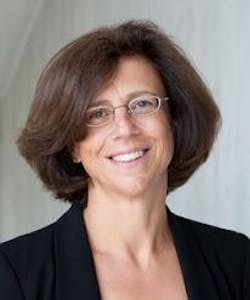Ultrafast laser researcher Ursula Keller wins 2013 LIA Schawlow Award

Orlando, FL--Ultrafast laser research pioneer, Dr. Ursula Keller, ETH Zurich professor, is the 2013 recipient of the Laser Institute of America's (LIA’s) Arthur L. Schawlow Award. Keller is also the first female winner of this award and will receive her honor during the awards luncheon at LIA's 32nd annual International Congress on Applications of Lasers & Electro-Optics (ICALEO) (http://www.icaleo.org), to be held October 6-10 at the Hyatt Regency Miami Hotel.
"My fundamental mission is to explore and push the frontiers in ultrafast science and technology, using interdisciplinary understanding of the physics of lasers, semiconductors, and measurement technologies," Keller says of her current work. "One of my current focus areas is high average power ultrafast lasers, where we push the performance frontier with SESAM (http://www.laserfocusworld.com/articles/print/volume-49/issue-02/features/fiber-lasers--two-micron-thulium-doped-fiber-lasers-achieve-10-k.html) mode-locked thin-disk lasers into the multi-100 W average output power regime. We have pushed pulse energy and the average power of ultrafast laser oscillators by four orders of magnitude from typically 1 nJ to >10 µJ and from [approximately] 100 mW to >270 W directly from laser oscillators without additional amplifiers."
Another focus of her efforts is on novel ultrafast semiconductor lasers, working toward more compact and less-expensive ultrafast devices. "We made fast progress in output power and pulse duration after the first demonstration of passively mode-locked external cavity surface emitting lasers (VECSELs) in collaboration with Prof. Anne C. Tropper in 2000. A more recent highlight is a femtosecond VECSEL with more than 1 W average output power."
A professor of physics at ETH since 1993, Keller leads the Ultrafast Laser Physics group and has been a director of the Swiss multi-institute NCCR MUST program in ultrafast science since 2010.
Born 1959 in Zug, Switzerland, she received a physics degree from ETH Zurich in 1984 and her doctorate in applied physics from Stanford University in 1989. She was a Member of Technical Staff at AT&T Bell Laboratories in NJ from 1989 to 1993. She was a Visiting Miller Professor at UC Berkeley in 2006 and a visiting professor at the Lund Institute of Technologies in 2001.
Keller's passion for lasers, their value and their future, is a key reason LIA is honoring her with the Schawlow Award.
"Lasers will move deeper and deeper into every computer platform, with optical clocks, interconnects and cables," she asserts. "As has been pointed out many times before, photons are ideal for communication and electrons for switching. So there will be closer and stronger integration of both elements in future technology. Laser micromachining will become more important, and the progress in high average power ultrafast lasers will allow for many new material processing capabilities. Lasers are an ideal technology platform that enable[s] truly multi-disciplinary research and applications ranging from engineering to life sciences. What other technology can offer so much variety?"
She is also excited to serve as a role model for young women who might wish to join the laser industry.
"Laser science and technology is traditionally a very male-dominated field, probably because it comes from electrical engineering and physics," she explains. "I hope we can attract more women into these areas in the near future because we cannot afford to keep losing half of our young talent pool. I always loved lasers, and I very much have enjoyed building and improving them for many years. As a community, we need to make a stronger effort to create a working environment where women feel welcome, can integrate, become motivated and can be empowered."
LIA first presented the award in 1982 to Schawlow, who won the Nobel Prize in physics in 1981. The honor recognizes individuals who have made distinguished contributions to applications of lasers in science, industry, or education.
SOURCE: Laser Institute of America; http://www.lia.org/blog/2013/07/2013-arthur-l-schawlow-award-winner-ursula-keller/#more-3053

Gail Overton | Senior Editor (2004-2020)
Gail has more than 30 years of engineering, marketing, product management, and editorial experience in the photonics and optical communications industry. Before joining the staff at Laser Focus World in 2004, she held many product management and product marketing roles in the fiber-optics industry, most notably at Hughes (El Segundo, CA), GTE Labs (Waltham, MA), Corning (Corning, NY), Photon Kinetics (Beaverton, OR), and Newport Corporation (Irvine, CA). During her marketing career, Gail published articles in WDM Solutions and Sensors magazine and traveled internationally to conduct product and sales training. Gail received her BS degree in physics, with an emphasis in optics, from San Diego State University in San Diego, CA in May 1986.